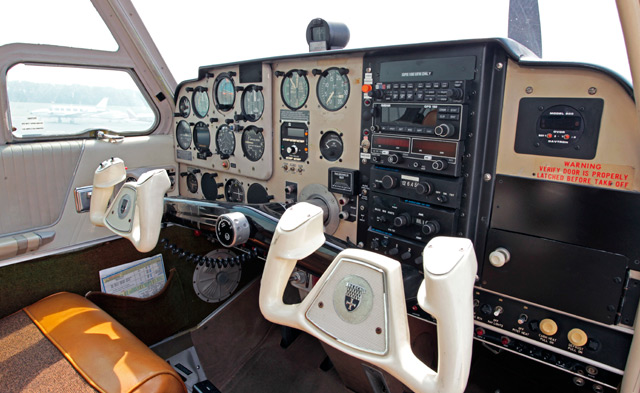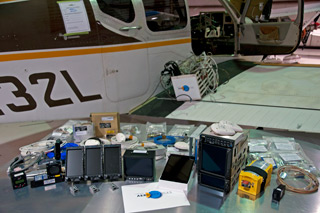Avionics: Panel prep
Taking a 1960s panel into the twenty-first century
Panel contributors

The original panel (above) will be replaced with a modern design loaded with the latest avionics.
The Debonair Sweepstakes airplane began life with avionics typical of the early 1960s era. The center radio stack was dominated by a Narco Mark V radio package—a pair of massive Nav/Comms and a Narco AT 50 transponder, topped off with an equally large Motorola T-12 ADF (automatic direction finder, for those who may have forgotten). The T-12 featured rotary dial-in tuning, and exuded all the ambiance of a tube-powered avionics world that would soon—blessedly, some would say—come to an end. In 1970, the Debonair’s owner apparently tired of the Mark V, and swapped it out for a Bendix M450 radio package. The T-12 stayed, maybe out of nostalgia.
In 1980, an Alcor exhaust gas temperature (EGT) gauge was installed, reflecting then-state-of-the-art engine management. Then came a Bendix/King KX-155 nav/com, an S-Tec System 50 autopilot, followed by a Garmin GPS 150—bought used in 2008 and installed with a “VFR Use Only” placard. Finally, in 2012, the T-12 was ditched; guess nostalgia has its limits. And that pretty much brings us up to date on the Debonair’s panel at the time AOPA took delivery in September 2012. By then it was pretty cranky. The GPS worked well but, predictably, the database had long ago expired. The KX-155s worked well, as did the System 50 and the transponder. But the remaining Narco com radio’s tuner could only dial up a certain range of frequencies, and the heading indicator precessed like mad—probably because the (wet) pneumatic pump produced such feeble suction that its gauge seldom pointed much above rock-bottom redline.
 Here are the Debonair’s new avionics, ready for installation. Note the three vertical Aspen Avionics displays on the left, and the Garmin GTN 750 and 650 on the right. The yellow box is a 406 MHz ELT. What’s that on the wingwalk? All of the 50-year-old wiring, yanked with the rest of the original equipment. Meanwhile, the panel is gutted, and awaits its full-blown upgrade.
Here are the Debonair’s new avionics, ready for installation. Note the three vertical Aspen Avionics displays on the left, and the Garmin GTN 750 and 650 on the right. The yellow box is a 406 MHz ELT. What’s that on the wingwalk? All of the 50-year-old wiring, yanked with the rest of the original equipment. Meanwhile, the panel is gutted, and awaits its full-blown upgrade.
In short, the panel was a hodge-podge of obsolete and dysfunctional instruments. This made the airplane perfect for a full-blown restoration project, so shortly after AOPA bought it the search began for an avionics shop up to the task. We found it in Santa Fe Aero Services, based at both the Santa Fe Municipal and Albuquerque International Sunport, New Mexico, airports. Santa Fe Aero Services has a reputation for quality, ambitious panel makeovers, as well as plenty of experience installing Aspen Avionics’ Evolution series of primary and multifunction displays and their related components.
Center stage
Familiarity with Aspen technology will definitely come in handy with the Debonair Sweepstakes. That’s because a three-screen Aspen Avionics avionics suite will take center stage on the instrument panel.
The Aspen setup will be the Evolution 2500, which comprises a central primary flight display (PFD), plus two multifunction displays (MFDs). This makes it possible to show a wide range of information that boosts situational awareness immensely. Want to show primary flight information superimposed on synthetic vision views of the surface below, plus electronic charts, terrain and obstacle warnings, datalink Nexrad and other weather overlays—and much, much more? You have it with the Evolution 2500, along with PFD redundancy, dual HSIs, and dual GPSs. All of these features make Aspen a popular choice in the retrofit market—and that regard makes our/your Debonair a stellar candidate for this spectacular upgrade. How better to bring a creaky, early sixties panel into contemporary status?
Pride of place in the center stack goes to a full set of the latest Garmin avionics. Garmin, contributors to AOPA’s sweepstakes renovations since 1994, is providing its new GTN750 GPS/nav/com navigator which, with its touch-screen functionality and large, 6.9-inch diagonal screen size, is capable of showing flight planned routes, plus traffic and datalink weather.
We’re adding Garmin’s GDL 88 datalink receiver to the package as well, so that all ADS-B and other traffic will be displayed—as well as XM WX datalink weather. Together with the Evolution 2500’s information, that means redundancy to the max.
But wait, there’s more. Garmin’s GTN650 will serve beneath the 750, providing additional capability via its own GPS/nav/com capabilities. And it, too, has touchscreen tuning.
PS Engineering’s PMA8000BT will serve as the audio panel managing all the nav/com inputs, but this unit is much more than a traditional audio panel. It can record your recent radio transmissions and ATC calls, keep passengers in or out of the communications loop and—best of all, in my opinion—be used to make telephone calls via a Bluetooth (that’s the “BT”) connected smartphone.
Kelly Manufacturing Company’s R.C. Allen standby attitude indicator will be on board in case the very worst happens. This two-inch diameter instrument has its own battery backup in the rare event that all electrical power is lost. CO Guardian is providing its Aero-553 carbon monoxide detector/clock, which will also be aboard the Debonair. And speaking of clocks, a new Davtron MB800, yoke-mounted clock is to grace the pilot yoke.
Engine management, and new twists
Sorry, but the original analog engine gauges will be tossed—in favor of J.P. Instruments’ EDM-900 engine analyzer system. The EDM-900 will permit a complete accounting of engine parameters such as exhaust gas temperatures, cylinder head temperatures, power output, as well as fuel and electrical system status. Before the EDM-900, the best a pilot could do when leaning the mixture was to use the Alcor single-point EGT gauge. Now, operations both rich and lean of peak EGT can be precisely set with the EDM-900.
Now for some interesting new twists. Alpha Systems has provided the airplane with its angle-of-attack (AOA) indicator. The indicator’s fast-slow indicator will be mounted right on the glareshield—right in the pilot’s field of view, and mounted just like the AOAs you see in military airplanes or business jets. Fly an approach with the AOA’s target “doughnut” lit up, and you’ll be on speed for every landing. It’s a feature that any pilot will greatly appreciate.
Santa Fe Aero is preparing an installation that will allow an iPad Mini to be panel-mounted, yet removable for portable use. No more power cables, and no more iPad-falling-to-the-floor issues! The iPad mini—via Garmin’s Pilot app—will have its own source of Flight Information Service-Broadcast (FIS-B) and ADS-B-In traffic detection capability via Garmin’s GDL 39 datalink receiver, so all of the free, government-provided weather and traffic information will be fully represented in this unique cockpit. In this sense, the Debonair’s pilot will get a jumpstart on the future; by 2020, all airplanes must be equipped with ADS-B equipment.
But get this: the iPad Mini can be used to create flight plans, then send them wirelessly to the Aspen system, where they are loaded automatically. No more manually dialing up identifiers and creating flight plans! You can send a flight plan from the mini to the airplane while you’re in the airport lounge, for that matter. It’s all part of Aspen’s Connected Panel—a new capability that integrates wireless smartphones, tablet computers, and other similar devices with the airplane’s certified hardware. Connected Panel is a bold new step forward that promises more enhancements in the very near future.
We’ve covered all the bases with this Debonair’s new panel, so it will take a couple of months for all the components to be installed. Take a look at Santa Fe Aero’s accompanying line drawing on page 86 to get an idea of what will go where. Look for more updates on the Debonair Sweepstakes in AOPA Pilot, on our website, and on AOPA Live This Week—our weekly web-TV news show.
Email [email protected].


